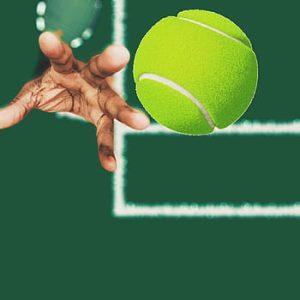We may earn money or products from the companies mentioned in this post.
Brief Overview of Tennis Racket Lifespan

When it comes to tennis, the lifespan of a racket is an important consideration for players A tennis racket is not just a piece of equipment; it’s an extension of the player’s skill and style Understanding the factors that can influence the longevity of a racket is crucial in ensuring peak performance on the court
Factors That Can Influence Longevity
Several factors come into play when determining how long a tennis racket will last One such factor is frequency of use Rackets that are used more often, especially by avid players or professionals, may wear out faster than those used less frequently
The type of playing surface also plays a significant role in racket lifespan Hard courts, with their abrasive surfaces, can cause more wear and tear on rackets compared to softer clay or grass courts
The way a player maintains and cares for their racket also affects its lifespan Regularly inspecting the strings for signs of wear and restringing when necessary can prolong the life of a racket Additionally, keeping the racket properly stored and protected from extreme temperatures or humidity can help prevent damage
Importance of Understanding Racket Lifespan for Players
For any serious tennis player, understanding the lifespan of their racket is essential for maintaining consistency in their game As rackets age and deteriorate, they can lose tension in their strings, leading to less control and power when hitting shots
By knowing how long their racket typically lasts, players can plan ahead and ensure they have a replacement ready when needed This prevents any sudden disruptions to their game due to equipment failure or decreased performance
Furthermore, understanding racket lifespan allows players to make informed decisions when purchasing new rackets They can choose a racket that aligns with their playing frequency and style, taking into consideration factors like durability and string tension maintenance
In conclusion, the lifespan of a tennis racket is influenced by various factors such as usage frequency, playing surface, and maintenance Understanding this lifespan is crucial for players who want to maintain optimal performance on the court By being aware of how long their rackets typically last, players can plan ahead and make informed decisions when it comes to equipment replacement So, next time you step onto the court, remember to keep an eye on your trusty racket’s longevity!
Factors affecting the lifespan of a tennis racket

When it comes to the lifespan of a tennis racket, several factors come into play Understanding these factors can help you make informed decisions about your equipment and prolong its longevity Let’s delve into the key elements that impact how long your racket will last
Frequency of play
The frequency at which you use your tennis racket has a direct impact on its lifespan Regular use puts stress on both the frame and strings, gradually weakening them over time Whether you’re a professional or an amateur player, the more often you play, the quicker your racket will wear out
Quality of materials and construction
The quality of materials used in crafting a tennis racket plays a significant role in determining its durability Rackets can be made from various materials such as aluminum, graphite, or composite blends Higher-quality rackets tend to incorporate advanced technologies and superior craftsmanship, making them more resilient compared to their low-quality counterparts
Maintenance and care practices
Proper maintenance and care practices are essential for maximizing the lifespan of your tennis racket Storing it correctly when not in use is crucial to preserve its integrity Avoid leaving it exposed to extreme temperatures or excessive moisture that could damage the frame or strings
Restringing also affects the life expectancy of your racket Regularly restringing ensures optimal string tension, which directly impacts performance and longevity Keeping an eye out for signs like frayed strings or loss of tension is vital in knowing when it’s time for a restring
Playing style and technique
Your playing style and technique have an undeniable influence on how long your tennis racket lasts Aggressive players who frequently hit powerful shots and generate more force will experience greater wear and tear on their rackets On the other hand, defensive players who rely on finesse shots may put less strain on the racket
Additionally, using proper hitting technique can help avoid unnecessary damage to your racket Developing good form and consistently hitting the ball in the racket’s sweet spot can minimize stress on the frame and strings, ultimately extending its lifespan
Comparison between different types of rackets based on lifespan

Entry-level rackets
When it comes to entry-level rackets, durability is a key consideration for beginners These rackets are designed to withstand the learning curve and provide reliable performance throughout the initial stages of your tennis journey While they may not offer the same longevity as higher-end options, entry-level rackets typically have a decent lifespan that can endure regular practice sessions and matches
In terms of materials, entry-level rackets often feature aluminum or composite frames combined with synthetic strings These materials strike a balance between affordability and durability, providing adequate strength and stability for beginners without breaking the bank
Intermediate level rackets
As players progress from beginner to intermediate level, their racket needs evolve accordingly Durability expectations increase as intermediate players start to refine their technique and engage in more intense gameplay
Intermediate level rackets commonly employ advanced materials such as graphite or carbon fiber in their frames These materials offer enhanced strength and stiffness, allowing for improved power and control on the court Additionally, technological advancements like vibration dampening systems are often integrated into these rackets to minimize shock and improve comfort during play
Advanced/professional level rackets
For professional players at the top of their game, racket lifespan becomes even more critical due to the rigorous demands placed upon them during high-level competition
Advanced/professional level rackets are constructed using top-of-the-line materials such as high modulus graphite or even exotic blends like Kevlar or basalt fibers These premium materials provide unparalleled strength while minimizing weight, allowing professionals to generate maximum power and maneuverability on the court
The choice of technology incorporated into these rackets also plays a significant role in their lifespan From advanced stringing patterns to customizable weight distribution, professional rackets are fine-tuned to meet the specific requirements of individual players
Considering the intense use and high-performance expectations at this level, professional rackets may have a slightly shorter lifespan compared to entry-level or intermediate options However, with proper care and maintenance, they can still deliver exceptional performance for an extended period
Tips for Extending the Life of Your Tennis Racket

When it comes to maximizing the lifespan of your tennis racket, proper handling during gameplay is crucial Avoiding common mistakes that often lead to damage can significantly extend the life of your racket and save you from unnecessary expenses
Avoiding Common Mistakes that Lead to Damage
One of the most common mistakes players make is forcefully hitting the frame against hard surfaces, such as the court or net posts This can cause cracks or fractures in the racket’s frame, ultimately compromising its structural integrity Instead, focus on hitting the ball cleanly and using controlled strokes without excessive force
Another mistake to avoid is throwing your racket in frustration or anger Not only does this display poor sportsmanship, but it can also result in damage to the racket The impact from throwing can cause dents or deformations in the frame or even break strings
Cleaning and Maintaining Your Racket Regularly

To keep your tennis racket performing at its best, regular cleaning and maintenance are essential However, it’s important to use effective cleaning methods that won’t harm your racket’s materials
Effective Cleaning Methods without Causing Harm
Start by removing any loose dirt or debris from the surface of your racket using a soft brush or cloth Avoid using abrasive materials that could scratch or damage the frame or strings
If there are stubborn stains on your grip, you can use a mild soap solution and a damp cloth to gently clean it Be sure to rinse off any soap residue thoroughly and allow it to air dry afterwards
Additionally, regularly inspecting your strings for signs of wear and tear is crucial for maintaining optimal performance If you notice frayed or loose strings, it’s best to have them replaced by a professional stringer
Knowing When to Replace Your Racket
Despite your best efforts to care for your racket, there comes a time when replacing it is necessary Recognizing the signs and understanding what to consider when choosing your next tennis racket can help you make an informed decision
Signs It’s Time for an Upgrade
If you notice significant cracks or damage to the frame that affects its stability, it may be time for a new racket Additionally, if you experience a noticeable decline in performance or feel discomfort while playing, these could be indications that your current racket no longer suits your playing style
Considerations When Choosing Your Next Tennis Racket
When selecting a new racket, factors such as weight, balance, and grip size should be taken into account Choose a racket that complements your playing style and level of expertise Consulting with knowledgeable professionals at tennis specialty stores can also provide valuable insights and guidance in finding the perfect racket for you
Conclusion

In conclusion, understanding the lifespan of a tennis racket is crucial for both recreational and professional players Tennis rackets are not indestructible and have a limited lifespan due to the wear and tear they endure during gameplay By being aware of this, players can make informed decisions about when to replace their racket, ensuring optimal performance on the court
The Importance of Understanding Tennis Racket Lifespans
Understanding the lifespan of a tennis racket allows players to gauge its condition and effectiveness As rackets age, they may lose tension in their strings, which can lead to reduced power and control Additionally, the frame may become weakened or damaged over time, impacting overall performance By recognizing these signs and knowing when it’s time for a replacement, players can prevent frustration on the court and maintain consistent gameplay
Proper Care and Maintenance Practices for a Longer-Lasting Racket
To extend the lifespan of your tennis racket, proper care and maintenance are essential First and foremost, storing your racket in a protective case or bag when not in use will shield it from unnecessary damage or exposure to extreme temperatures Regularly inspecting your racket for any signs of wear or damage is also crucial; if you notice frayed strings or cracks in the frame, it’s advisable to seek professional restringing or consider replacing your racket altogether
Cleaning your racket after each use using specialized cleaning products will help remove dirt and sweat that can accumulate over time This practice not only keeps your equipment hygienic but also prevents premature deterioration Finally, avoiding excessive force or misuse during gameplay is vital for preserving your racket’s longevity Taking care to avoid hitting surfaces other than tennis balls (such as nets or hard courts) will minimize unnecessary stress on both the strings and frame
Incorporating these care and maintenance practices into your routine will not only prolong the lifespan of your tennis racket but also contribute to consistent performance By investing time and effort into caring for your equipment, you can ensure that it remains in optimal condition, allowing you to fully enjoy the game and achieve your best on the court
Useful Links

How long does a tennis racket last?
Racquet Trouble: How Long Do Tennis Racquets Last?
Ask the Stringer: Do Tennis Racquets Ever Wear Out? …
How Often Should I Re-String My Tennis Racket?
How to String a Tennis Racquet: 13 Steps (with Pictures)
How long do padel rackets last and how to make your …
How Long Do Tennis Racquet Strings Last? – TennisFocusOn
How often should you Change Tennis Strings?
Does A Good Tennis Racket Make A Difference
Extended Length Tennis Rackets – What Are They & Who …
How Long Does a Tennis Racket Last: You Must Know
Do Tennis Racquets Wear Out? – Everything You Need To …
4 Tips to Make Your Tennis Racket Last Longer
How often should one replace/upgrade one’s tennis racket?
Lifespan of a Padel Racket
How to String a Tennis Racket | Step by Step (with Pictures)
Basic Racket Care
Do Tennis Racquets Wear Out? What You Need to Know …
How to String a Tennis Racket






